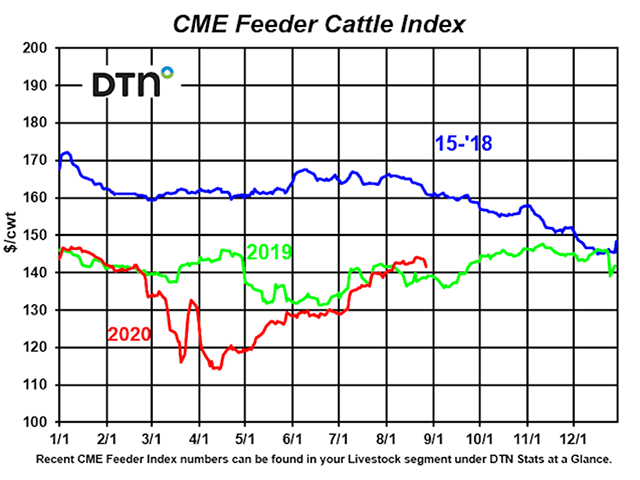Sort & Cull
Feeder Cattle: Good Prices Compared to What?
Taking a look at the current market price trend (red line) without perspective of what is going on in the market or historical data, one would think that the 24% rally in feeder cattle index prices over the past four months is impressive.
And really, the scope and ability to regain support in this market structure is generally impressive and should not be taken too lightly.
Feeder cattle prices have moved back to pre-COVID levels with uncertainty of beef demand growth over the coming weeks and months, making the price resiliency generally noteworthy. It is important to note that current index price levels have moved above year-ago levels (green line) and could continue to trend in that direction over the short term, given current support seen in the market.
But this is the point where "good" market prices become relative. Current price levels are still well-below production costs for cow-calf producers and are nearly $20 below the previous three-year average price levels (blue line). This will continue to add underlying pressure to the industry, as current supply levels and concerns that beef supplies will outpace demand through the end of the year may keep feeder cattle prices well-below the longer-term market trend.
P[L1] D[0x0] M[300x250] OOP[F] ADUNIT[] T[]
Traditionally, seasonal pressure develops during the fall months with prices typically hitting seasonal highs in late July and early August. It appears that in 2020, seasonal highs have developed in late August, signaling a possible moderate pullback over the next several weeks.
Uncertainty about further cattle placements and feeder cattle sales continues to create additional caution to the industry, limiting the potential for prices to break out of this current market trend.
Higher feed prices and hay shortages in drought-affected areas of the country has quickly led to selling decisions for many cattle producers based on weather factors and not prices available. As of the latest cattle on feed report, at the end of July, cattle placements in 2020 (14.2 million head) are at the lowest levels since 2016. At this point in the year, 63% (past 10-year average) of yearly cattle have been placed in feedlots by the end of July, indicating that, if this trend continues to develop, overall placements would come in nearly 900,000 head less than 2019 levels.
These tighter supplies should help to support live cattle and beef price levels during 2021, but for now, there remains so many unanswered questions about potential beef demand that make the road ahead foggy at best. Over the last decade, placement numbers have peaked every year in October. There is no indication that this will change, despite the active feeder cattle sales activity over the last few weeks and disrupted pattern of placements through the entire year.
The end result of beef hitting the market when these cattle reach market-ready weights will likely create significant price variability through much of 2021.
Although feeder cattle prices are much better than they have been, the fact that they are significantly below where they could, or potentially should be, will continue to add volatility and uncertainty through the cattle market as fall sales increase within the coming weeks. This could create short- and long-term implications as cattle producers could begin conversations regarding their herd size and/or if they even want to remain in the cattle business at all. So, for many, "good" is likely not to be "good enough" given the current conditions and uncertainty in the market.
Rick Kment can be reached at Rick.Kment@dtn.com
© (c) Copyright 2020 DTN, LLC. All rights reserved.





Comments
To comment, please Log In or Join our Community .